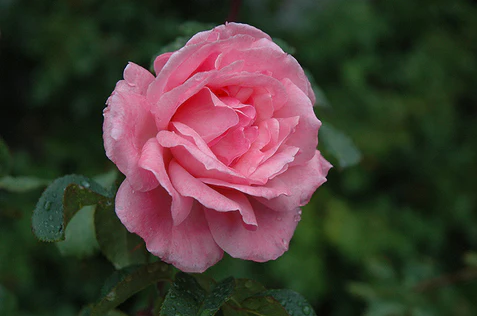
The Queen Elizabeth rose, officially named Rosa ‘Queen Elizabeth’ is a worldwide popular rose and can be found in gardens, parks, and commemorative plantings. This rose blooms profusely throughout the growing season, from late spring to frost.
Developed by Dr. Walter Lammerts and introduced in 1954, the rose was named to honor Queen Elizabeth II’s ascension to the throne. Its popularity skyrocketed, winning prestigious awards like the All-America Rose Selections (1955) and the American Rose Society Gold Medal (1957).
The Queen Elizabeth rose has an upright and vigorous growth habit, reaching a mature height of 4-6 feet. It forms a bushy shrub with minimal thorns. It features large, 4-inch blooms with a classic, high-centered to cupped shape. They have a clear pink color, sometimes with a silver-pink tinge, and have a moderate number of petals (around 38-40). The Queen Elizabeth rose thrives in USDA zone 5b through 9b.
The Queen Elizabeth rose is a cross between the ‘Charlotte Armstrong’ and ‘Floradora’. There’s some debate about the exact classification of the Queen Elizabeth rose. While some sources categorize it as a Floribunda rose (known for clusters of blooms), others classify it as a Grandiflora rose (a hybrid between Floribundas and Hybrid Teas, known for larger, single blooms).
The Queen Elizabeth rose has been used to hybridize 30 new rose cultivars, and several color sports have been introduced, including ‘Yellow Queen Elizabeth’ and ‘White Queen Elizabeth’. A climbing sport, ‘Climbing Queen Elizabeth’, was introduced in 1957 and is a very popular, vigorous climbing rose.
Characteristics of Queen Elizabeth Rose
- Size and Growth Habit: The Queen Elizabeth rose has an upright growth habit, forming a bushy shrub. It grows up to 10 feet tall with a spread of 3-4 feet. It also has few thorns on its stems.
- Growth Rate: It grows at a fast rate and under ideal conditions readily filling out its designated space.
- Flower: They have a classic, high-centered to cupped shape, reaching a diameter of around 4 inches. The color is a clear pink, sometimes with a subtle silver-pink tinge, and features a moderate petal count of 38-40.
- Bloom Time: This rose blooms profusely from early summer to mid-fall.
- Fragrance: While not overpowering, the rose offers a pleasant, light fragrance.
- USDA Zone: This rose thrives in a range of climates, performing well in USDA Hardiness Zones 5 to 9. In colder zones (zones 4 and below), it may require some winter protection to ensure its survival.
- Lifespan: Under ideal conditions, it can live for approximately 20 years.
- Hardiness: It performs well in both heat and moderate cold. In colder climates, protecting the plant during harsh winter months can help it survive and thrive.
- Disease Resistance: It shows moderate resistance to common rose diseases such as black spot and powdery mildew. While it is not completely immune, it generally requires less chemical intervention compared to more disease-prone varieties.
Cultivation Tips
- Planting: Plant in a sunny location with well-drained soil rich in organic matter. Ensure the site receives at least 6 hours of direct sunlight daily.
- Watering: Water regularly, especially during dry periods, to keep the soil consistently moist but not waterlogged. Deep watering encourages deep root growth.
- Fertilizing: Feed with a balanced rose fertilizer during the growing season to promote healthy growth and abundant blooms. Apply a slow-release fertilizer in early spring and a liquid fertilizer every 4-6 weeks during the growing season.
- Pruning: Prune in late winter or early spring to remove dead or weak growth and to shape the plant. This encourages vigorous flowering and maintains the plant’s form. Deadhead spent blooms to encourage repeat flowering.
- Mulching: Apply a layer of mulch around the base of the plant to retain moisture, suppress weeds, and regulate soil temperature.